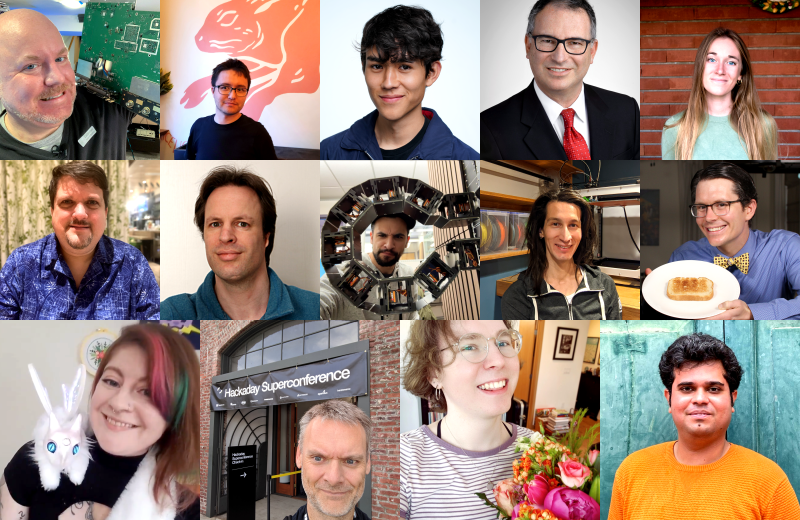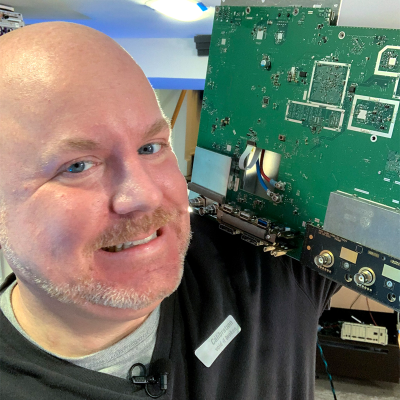Hackaday Supercon 2023 is almost upon us, and looking over the roster of fantastic talks gets us in the mood already. We hope that it has the same effect on you too.
Supercon is the Ultimate Hardware Conference and you need to be there! We’ll announce the rest of the speakers, the workshops, and give you a peek at the badge over the next couple weeks. Supercon will sell out so get your tickets now before it’s too late. And stay tuned for the next round of reveals on Tuesday!
A Hacker’s Guide to Audio/Video Formats
If you want to show a video clip or play audio in your project, you’ve probably had to figure out how to take that media file and turn it into something that runs on a small device. This talk with give an overview of the commonly supported formats, how well they work on typical maker hardware, and the kinds of problems you’re likely to hit. I’ll be mainly talking about working directly in C/C++, but also about prototyping with CircuitPython.
The Bits and Bytes of Bringing Arcade Classics to Game Consoles
I will go into some detail about the challenges, trade offs, and solutions encountered when porting some classic Namco arcade games such as Pac-Man, Dig-Dug, Galaxian, Pole-Position to the home console market, specifically the Gameboy Advance.
A Makers Guide To Designing Sheet Metal Electroncis Enclosures
Sheet metal is the dominant fabrication method for computer cases and electronics enclosures, but it’s seldom seen in DIY or open-source hardware projects. This talk is a crash course in sheet metal design for makers: How it works, basic design principles, and useful tips to get the most out of this versatile, cost-effective manufacturing option.
Circuit Boards that Breathe and Bend (A Guide to Electro-Pneumatic Robotic Surfaces)
How do you build a robotic, shape-changing surface? The brute-force approach is to use dozens of tiny, individual actuators — but the near-endless assembly process limits the scale of what you can realistically achieve. Instead, stick the actuators inside the circuit board itself! By hijacking the PCB layup process, and integrating smart materials into this manufacturing pipeline, we can create arrays of compact electro-mechanical actuators without the painful assembly steps.
Soft actuator orthosis
The use of soft robots in the medical field is still in its early stages. In this project, our aim is to demonstrate their potential by integrating them into an orthosis that utilizes a soft actuator to assist individuals in gripping objects effectively. This innovation holds the potential to significantly improve the quality of life for individuals with tenodesis, granting them greater independence in daily activities.
Tiny Reinforcement Learning in Robotics
Most of the major strides in reinforcement learning (RL) we see are in board games (Chess, Go), video games (Mario, Doom), and large robotics (self-driving cars). I examine how RL works on microcontrollers by providing a demonstration of a self-balancing inverted pendulum. Rather than manually tune PID controllers, we simply let AI figure it out.
Wireless Hacking on a $5 Budget (with Microcontrollers)
As microcontrollers become cheaper & more capable, this makes them perfect for building disposable hacking payloads – and especially for wireless reconnaissance!
In this talk, Alex Lynd shares how he builds low-cost hacking tools, wireless implants, and even a snail-mail payload that can phish your online credentials – all using $5 microcontrollers! He also discusses how he uses low-cost hardware to lower the barrier to entry for security researchers & cybersecurity beginners.
Building a Portable Vectrex, the Right Way
The Vectrex is an odd ’80s game console. It integrates a vector CRT in its case, as displaying vectors with the required clarity would be impossible on a TV with the tech at that time. The Vectrex sold decently well, but unfortunately, it was a victim of the 1983 video game crash. If that didn’t happen, perhaps a portable Vectrex, handheld and running on batteries, would have seen the light of day? This is a look into what could be, using modern digital electronics to drive a CRT for that original vector crispness you just can’t get on LCDs, combined with a relatively long battery life.
The Absurd Idea of Rendering KiCAD Projects on the Web
What would it take to show KiCAD files right there in your browser instead of having to download and view them on your computer? “That’s absurd!” you might shout, and you would be right! Absurdity is something I specialize in so I took on the task of building an open source, browser based KiCAD viewer – KiCanvas.
I’ll show you the glorious hacks, the beautiful optimizations, and the horrifying edge cases involved with dissecting and replicating KiCAD’s rendering on the web. I’ll share how interactive web technology can amplify open hardware.
Receiving Microwave Signals from Deep-Space Probes – Amateur DSN and the Ultimate DX
Amateur reception of deep space probes is a fascinating and challenging field that blends elements of microwave RF, space communications, space exploration, and radioastronomy.
While data from space probes is commonly received and processed by space agencies using very large antennas and sophisticated equipment, it is possible for hobbyists to home-brew modest systems capable of receiving signals from deep-space probes. This is currently one of the only ways in which private citizens can directly experience planetary exploration.
Building the Apple II computer that Apple intended but never did
This talk spans a four-year project initially intended to be a quick and easy “just wire this chip up” idea. (Sound familiar?) James set out to build a portable Apple IIe based on the Apple “Mega-II” chip from the late 1980s. Something that not even Apple ever did! To make it happen, he had to reverse engineer the (mostly) undocumented ASIC and learn more about the Apple II hardware architecture than a single person should.
The result is the first Apple IIe-compatible computer built relying on the Mega-II — not even the IIGS can claim this!
Going Into Deep (Logic) Waters with the Raspberry Pi Pico’s PIO and the Pi’s SMI
The Raspberry Pi Pico (RP2040 MCU) has a pretty interesting internal bus architecture – which includes striping of the internal RAM into banks, and a crossbar bus which allows both its cores, DMA and peripherals to concurrently work and orchestrate data transfers as long as nobody tramples on each other’s feet (so to speak). I will talk about my journey making a logic analyser that uses SMI and the challenges I faced, how fast can I push the boundaries of speed and achieve the full potential that the Pico/Pi combo has to offer.
Programming Your Human Hardware Compilers, or the Road to Writing Great Step-by-Step Instructions
If software gets a compiler, then what stands in for mechanical hardware? Often, the answer is a set of hand tools–and you! You, the human, must compile the mechanical design that exists in a computer model into a working, moving project. As the project designer, we have a chance to literally program the behaviors of assembly into step-by-step instructions, guiding the human on a path to victory.
While many people might call documenting projects a chore, I’ll showcase my strategies for saving time, and demonstrate how the process can be fulfilling and, I daresay: fun.
Cuddly Companion Bots: A Whimsical Adventure
Inspired by fellow botmakers Alex Glow and Jorvon Moss at Supercon 2019, I decided to embark on a journey to build my own cuddly companion named Nova. In the process of crafting a companion bot that felt creative and alive, I was able to expand my skill set and create some whimsical features that evoke emotional reactions from people who interact with her.
After bringing her to Supercon 2022, I then decided to share my process of crafty robots with others through a summer camp for tweens at a public library. I will showcase some tips for artists and designers dipping their toes into the companion bot world for the first time and ways you can create compelling bots with simple materials.
[If you read this far, you probably want tickets. Just sayin’.]




























Why does the picture of Shawn Hymel holding a piece of toast on a plate seem perfectly normal to my brain? Like it doesn’t trigger a “huh, weird”, just like, “yep, there he is in his natural habitat.”
Also, stop trying to tempt me out of The Alley with these super interesting talks.
I assume his presentation will be early in the day and he’s offering (bribing) to make breakfast for those who show up.
Shawn, I’d like to put in a request for a large caramel roll and a large latte.
B^)
The toast is a tribute to my talk from last year: https://www.youtube.com/watch?v=ja5HU18KvPk. Sadly, no toast this year!
I start to calm down and then an announcement like this comes through and I get all geeky inside. I have so much to do before Supercon. After Supercon my attention shifts, but the knowledge gained takes me to new arenas.
“If you read this far…” Get tickets before they’re gone.
See you there.
Will be interested to see what Kumar Abhishek’s Pi-based logic analyser is capable of, after he made the BeagleLogic cape and BeagleLogic Standalone board.
Thank you for expressing your excitement! I’m pretty excited and nervous at the same time for the talk, really looking forward to the conference.
Will any of these talks be available to stream after the fact? Between travel and ticket price it is way out of my budget, but I’d be very interested in some of these talks.